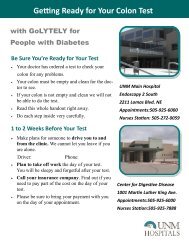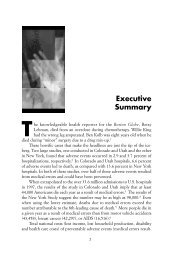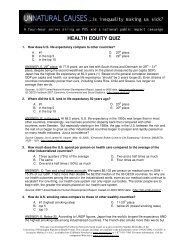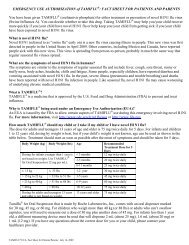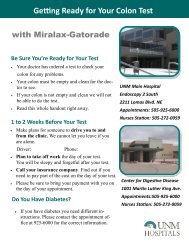Good Nutrition in Parkinson's - St. Louis APDA
Good Nutrition in Parkinson's - St. Louis APDA
Good Nutrition in Parkinson's - St. Louis APDA
- No tags were found...
You also want an ePaper? Increase the reach of your titles
YUMPU automatically turns print PDFs into web optimized ePapers that Google loves.
<strong>Good</strong> <strong>Nutrition</strong>INPARKINSON’SDISEASEThis booklet was orig<strong>in</strong>ally written under a grant agreement for the American Park<strong>in</strong>son DiseaseAssociation, Inc, by Julie H. Carter, RN, MN, Adult Nurse Practitioner, Department of Neurology,Oregon Health Sciences University, Portland, Oregon, ©1992. It was redesigned and repr<strong>in</strong>ted <strong>in</strong>1999 through an unrestricted educational grant from Pharmacia & Upjohn Company and Boehr<strong>in</strong>gerIngelheim Pharmaceuticals, Inc.The American Park<strong>in</strong>son Disease Association, Inc1250 Hylan Boulevard, Suite 4B, <strong>St</strong>aten Island, NY 10305Telephone: 1-800-223-2732
INTRODUCTIONWhen you have Park<strong>in</strong>son’s disease or any chronic illness, one important th<strong>in</strong>g you can do for yourselfis to make sure you are eat<strong>in</strong>g correctly. Your body will work better if your nutrition is optimal. You willhave more energy, your medication will work better, and you will feel more like exercis<strong>in</strong>g. In the lastfew years, it has been shown that a diet low <strong>in</strong> prote<strong>in</strong> can benefit some people with Park<strong>in</strong>son’sdisease. Nonetheless, use of this diet without the proper attention to all nutritional needs can result <strong>in</strong>nutritional deficits.This booklet is <strong>in</strong>tended to help patients and families understand good nutrition as it applies to ag<strong>in</strong>gand chronic illness. The benefit of the low-prote<strong>in</strong> diet will be addressed, who should use it, how itshould be used, and some potential nutritional limitations. F<strong>in</strong>ally, a practical approach to the use ofthe low-prote<strong>in</strong> diet is <strong>in</strong>cluded with a list of resources and recipes.2
RESOURCESDieticiansTo get the number of a dietician <strong>in</strong> your area, check the yellow pages under “dietician.”Be sure the dietician is registered or licensed.Or call the American Dietetic Association at 1-800-877-1600, Ext 4898, and ask for the qualifieddieticians <strong>in</strong> your area.Low-Prote<strong>in</strong> ProductsThese resources can provide <strong>in</strong>formation on low-prote<strong>in</strong> foods.Dietary Specialties offers a variety of low-prote<strong>in</strong> foods. Price list and order formmay be obta<strong>in</strong>ed by call<strong>in</strong>g the number below.Dietary Specialties, IncPO Box 227Rochester, NY 14601(716) 263-27871-800-544-0099Ener-G Foods is a northwest company that can provide low-prote<strong>in</strong> recipes and foods.Ener-G Food, Inc5960 1st Avenue SSeattle, WA 98124(206) 767-6660General Mills can provide <strong>in</strong>formation on the prote<strong>in</strong> content of most food.General Mills, IncPO Box 200M<strong>in</strong>neapolis, MN 55440(612) 540-23113
TABLE OF CONTENTSPr<strong>in</strong>ciples of <strong>Good</strong> <strong>Nutrition</strong> ..................................................................................................................................5Important Nutrients: Why Are They Important and How Much Should You Eat?Carbohydrates...............................................................................................................................................6Prote<strong>in</strong> ..........................................................................................................................................................7Fats...............................................................................................................................................................9Vitam<strong>in</strong>s......................................................................................................................................................10M<strong>in</strong>erals......................................................................................................................................................12Prevention of Malnutrition: Who Is at Risk?.........................................................................................................15A Special Diet for Park<strong>in</strong>son’s Disease.................................................................................................................16Practical Guidel<strong>in</strong>es for a Well-Balanced Diet <strong>in</strong> Park<strong>in</strong>son’s Disease..................................................................19Prote<strong>in</strong> Exchange List for Assistance <strong>in</strong> Design<strong>in</strong>g Reduced-Prote<strong>in</strong> Diets ..........................................................21Meat List.....................................................................................................................................................23Milk List......................................................................................................................................................23Bread & <strong>St</strong>arch List.....................................................................................................................................24Vegetable List..............................................................................................................................................24Fruit List .....................................................................................................................................................24Fat List........................................................................................................................................................24Prote<strong>in</strong>-Free List .........................................................................................................................................25Low-Prote<strong>in</strong> Recipes............................................................................................................................................26<strong>APDA</strong> Information and Referral Centers .......................................................................................Inside Back Cover4
Pr<strong>in</strong>ciples of <strong>Good</strong> <strong>Nutrition</strong>1. Eat a variety of food.This <strong>in</strong>cludes selections from each of the four food groups to ensure the right amounts of vitam<strong>in</strong>s,m<strong>in</strong>erals, carbohydrates, fats, and prote<strong>in</strong>s (Table 1).Table 1Basic Four Food GroupsGroupMeat2-3 serv<strong>in</strong>gsper dayFruit andVegetables4-5 serv<strong>in</strong>gsor more per dayMilk2-3 serv<strong>in</strong>gsper dayBread andCereal6-11 serv<strong>in</strong>gsper dayNutrientsProte<strong>in</strong>FatIronNiac<strong>in</strong>Thiam<strong>in</strong>B 12Z<strong>in</strong>cCarbohydratesVitam<strong>in</strong> CVitam<strong>in</strong> ACalciumIronVitam<strong>in</strong> EB ComplexCalciumFiberFolateProte<strong>in</strong>CarbohydratesFatRiboflav<strong>in</strong>Vitam<strong>in</strong> DCalciumCarbohydratesFiberNiac<strong>in</strong>Thiam<strong>in</strong>Riboflav<strong>in</strong>Iron2. Eat less fat.Eat<strong>in</strong>g a high-fat diet has been l<strong>in</strong>ked to heart disease. Fat can be lowered by eat<strong>in</strong>g more fish, poultry,and other lean meats. Dr<strong>in</strong>k low-fat milk and eat less ice cream, butter, and cheese.3. Eat more carbohydrates.Eat more complex carbohydrates (starches, cereals, and breads), especially those high <strong>in</strong> fiber. They area good source of energy, vitam<strong>in</strong>s, and m<strong>in</strong>erals.4. Ma<strong>in</strong>ta<strong>in</strong> a reasonable weight.The proper number of calories should be consumed to ma<strong>in</strong>ta<strong>in</strong> ideal weight. The person withPark<strong>in</strong>son’s disease has a tendency to lose weight rather than ga<strong>in</strong> weight. Nonetheless, excess weightcan worsen the exist<strong>in</strong>g problems of mobility.5. Avoid too much salt.Salt is a problem for people with high blood pressure or certa<strong>in</strong> heart conditions. In Park<strong>in</strong>son’sdisease, blood pressure can often be too low. If this is the case, and there are no heart problems,then salt does not need to be avoided.5
Important Nutrients:Why Are They Important andHow Much Should You Eat?CarbohydratesWhat is the role of carbohydrates <strong>in</strong> nutrition?Carbohydrates are sugars and starches and are the ma<strong>in</strong> source of energy <strong>in</strong> the diet. Theyare found <strong>in</strong> fruits, milk products, and bread products. One gram of carbohydrates supplies4 calories.What are calories?Calories are a unit of measurement used to express energy. They come from carbohydrates, prote<strong>in</strong>s,fat, and alcohol. The amount of energy required to susta<strong>in</strong> all bodily processes such as circulation,breath<strong>in</strong>g, muscle tone, and heartbeat is called the basal metabolic rate (BMR). The BMR varies from<strong>in</strong>dividual to <strong>in</strong>dividual but, on an average, requires 1,200 to 1,400 calories per day for women and1,600 to 1,800 calories for men. To ma<strong>in</strong>ta<strong>in</strong> an ideal weight, people should eat enough calories tosusta<strong>in</strong> their BMR plus their normal level of physical activity. If you <strong>in</strong>crease your physical activity, youneed more calories; and if you decrease it, you need fewer.Are there specific calorie recommendations for Park<strong>in</strong>son’s disease?The tendency <strong>in</strong> Park<strong>in</strong>son’s disease is to lose weight. The exact cause for this is unclear. Becauseof this, calorie needs should be <strong>in</strong>dividually assessed by a dietician us<strong>in</strong>g these steps:1. Determ<strong>in</strong>e ideal body weight us<strong>in</strong>g tables with standardized norms (values) for age, sex,height, and body frame. This will be used <strong>in</strong> addition to your <strong>in</strong>dividual past history of weight.2. Obta<strong>in</strong> a record of average daily food <strong>in</strong>take and calculate the number of calories eaten.3. Estimate the amount of calories used daily <strong>in</strong> physical activity. Although many people withPark<strong>in</strong>son’s disease are sedentary, it should be noted that abnormal <strong>in</strong>voluntary movements,or dysk<strong>in</strong>esia, can use as many calories as moderate physical exercise and should becalculated accord<strong>in</strong>gly.4. Compare the number of calories required to ma<strong>in</strong>ta<strong>in</strong> ideal weight to the amount currentlyeaten and make <strong>in</strong>dividual calorie recommendations.6
What is fiber and why is it important?Fiber is the part of the plant cell that cannot be digested and therefore cannot be absorbed by thebowel. Fiber is considered beneficial for the health of the <strong>in</strong>test<strong>in</strong>e, for regularity of bowel movements,and for a number of chronic diseases. Major sources of fiber are bran, fruits, vegetables, legumes, andwhole-gra<strong>in</strong> cereals.In Park<strong>in</strong>son’s disease, fiber is important <strong>in</strong> the management of constipation. It acts as a bulk<strong>in</strong>g agentby absorb<strong>in</strong>g water, which then helps promote evacuation of the bowel (Table 2).Table 2Management of Simple Constipation1. Eat a balanced diet, <strong>in</strong>clud<strong>in</strong>g fiber-conta<strong>in</strong><strong>in</strong>g food.2. Get adequate rest and relaxation.3. Do moderate rout<strong>in</strong>e exercises.4. Don’t put off the urge to move your bowels.5. Dr<strong>in</strong>k 6 to 8 glasses of water or noncaffe<strong>in</strong>ated dr<strong>in</strong>ks per day.6. Check with your health care provider to see if your medications are contribut<strong>in</strong>gto your constipation.7. Take a stool softener once or twice a day to manage simple constipation.8. For more severe constipation, consult your health care provider.Some laxatives used chronically can be toxic to your bowel.PROTEINWhat is the role of prote<strong>in</strong> <strong>in</strong> nutrition?Prote<strong>in</strong> is composed of elementary structures called am<strong>in</strong>o acids. The prote<strong>in</strong> you eat is broken down<strong>in</strong>to am<strong>in</strong>o acids <strong>in</strong> the stomach and <strong>in</strong>test<strong>in</strong>e and then absorbed <strong>in</strong>to the blood. These am<strong>in</strong>o acidsare the build<strong>in</strong>g blocks for new prote<strong>in</strong> used for build<strong>in</strong>g new tissue and repair<strong>in</strong>g old tissue. Tissueprote<strong>in</strong> of the body can also be broken down <strong>in</strong>to am<strong>in</strong>o acids and used for energy. This will occur ifthere are not enough carbohydrates and fats <strong>in</strong> the diet to provide energy. Prote<strong>in</strong> provides 4 caloriesper gram.There are 22 am<strong>in</strong>o acids, 9 of which cannot be made by the body and therefore must be provided bythe diet. These are called essential am<strong>in</strong>o acids. Thirteen can be made by the body and are callednonessential (Table 3).7
Table 3Essential Am<strong>in</strong>o AcidsNonessential Am<strong>in</strong>o AcidsHistid<strong>in</strong>ePhenylalan<strong>in</strong>eAlan<strong>in</strong>eGlutam<strong>in</strong>eIsoleuc<strong>in</strong>eThreon<strong>in</strong>eArg<strong>in</strong><strong>in</strong>eGlyc<strong>in</strong>eLeuc<strong>in</strong>eTryptophanAsparag<strong>in</strong>eHydroxyprol<strong>in</strong>eLys<strong>in</strong>eVal<strong>in</strong>eAspartic acidProl<strong>in</strong>eMethion<strong>in</strong>eCyste<strong>in</strong>eSer<strong>in</strong>eCyst<strong>in</strong>eTyros<strong>in</strong>eGlutamic acidWhere is prote<strong>in</strong> found?Prote<strong>in</strong> can come from either plant or animal sources. Animal sources <strong>in</strong>clude milk, meat, cheese, fish,poultry, and eggs. Plant sources are legumes, nuts, breads, cereals, and beans. Animal sources tend tobe higher <strong>in</strong> fat and cholesterol.How much prote<strong>in</strong> do we need?Most Americans eat more prote<strong>in</strong> than needed to meet the body’s needs. The recommended dailyallowance (RDA) for prote<strong>in</strong> is 0.8 grams per kilogram (0.36 g/lb) body weight. This would be 62grams of prote<strong>in</strong> for the 77 kilogram (170 lb) man and 52 grams of prote<strong>in</strong> for the 65 kilogram (143 lb)woman (Table 4). A quicker but slightly less accurate way to calculate RDA for prote<strong>in</strong> is 0.4 gramstimes body weight <strong>in</strong> pounds. The RDA for prote<strong>in</strong> is thought to be the same for ag<strong>in</strong>g and youngadult populations.It should be mentioned that RDA is calculated for healthy people and it may need to be modified<strong>in</strong> illness.Prote<strong>in</strong> deficiency can result <strong>in</strong> weight loss, reduced resistance to disease, sk<strong>in</strong> and blood changes,slow wound heal<strong>in</strong>g, and muscle wast<strong>in</strong>g.Table 4Calculat<strong>in</strong>g Prote<strong>in</strong> Requirements1 lb = 0.45 kg170 lb = 77 kg0.8 g x 77 kg = 62 g/170 lb body weight8
What are the recommendations for prote<strong>in</strong> use <strong>in</strong> Park<strong>in</strong>son’s disease?For good health, all park<strong>in</strong>sonian patients need a m<strong>in</strong>imum of 0.8 g/kg body weight per day (0.36 g/lb).Higher amounts of prote<strong>in</strong> have been found to <strong>in</strong>terfere with S<strong>in</strong>emet ® (carbidopa-levodopa) <strong>in</strong> somepeople with Park<strong>in</strong>son’s disease. Recommendations for prote<strong>in</strong> restriction will be described <strong>in</strong> thesection “A Special Diet for Park<strong>in</strong>son’s Disease.”FATSWhat is the role of fat <strong>in</strong> nutrition?Fats are a major source of energy. One gram provides 9 calories. Fats are found <strong>in</strong> meats, milkproducts, butter, and oils. Some foods from the bread group also conta<strong>in</strong> fat, such as pastries, cookies,biscuits, and muff<strong>in</strong>s.Although fats are very important <strong>in</strong> our diet, they have been implicated as a major contributor to heartdisease. There are different types of fats <strong>in</strong> our diet and these affect the cholesterol <strong>in</strong> our blood.Cholesterol is a fatlike substance, which has important functions <strong>in</strong> the body, but high levels <strong>in</strong> theblood have been l<strong>in</strong>ked to coronary artery disease. “<strong>Good</strong> cholesterol” is known as HDL (high-densitylipoprote<strong>in</strong>) and “bad cholesterol” is LDL (low-density lipoprote<strong>in</strong>).High levels of LDLs <strong>in</strong>crease heart disease risk, while high levels of HDLs reduce heart disease risk.The first l<strong>in</strong>e of therapy to reduce LDL is to reduce saturated fat and cholesterol <strong>in</strong> the diet. When diethas been altered and the LDL is still high, your physician may consider drug therapy to further lowerthe LDL.In the diet, saturated fats are, <strong>in</strong> general, the “bad fats,” s<strong>in</strong>ce they tend to <strong>in</strong>crease LDLs <strong>in</strong> the blood.Saturated fats come mostly from animal products such as butter, red meat, cheese, whole milk, andproducts made with whole milk. Saturated fats are also found <strong>in</strong> large quantities <strong>in</strong> some vegetableproducts such as coconut oil, palm oil, and vegetable oils that have been hydrogenated, suchas shorten<strong>in</strong>gs.The “good fats” are unsaturated, and they come <strong>in</strong> two classes: polyunsaturated and monounsaturated.These fats come ma<strong>in</strong>ly from plants and may help to reduce blood cholesterol (LDL), especially whenthey replace the saturated fats. Examples of polyunsaturated fats are safflower and corn oil. Olive,canola, and peanut oils are rich <strong>in</strong> monounsaturated fats.Fats are not simple. It is important to understand that the fat <strong>in</strong> a food is not purely a saturated fat orpurely an unsaturated one. The fat <strong>in</strong> any food or oil is a mixture of the types, but it is called saturatedor unsaturated depend<strong>in</strong>g on which fat predom<strong>in</strong>ates. For example, while the fat <strong>in</strong> peanuts or <strong>in</strong>chicken is mostly unsaturated, these foods also conta<strong>in</strong> significant amounts of saturated fats. Thismeans that even foods rich <strong>in</strong> “good fats” should be eaten <strong>in</strong> moderation.S<strong>in</strong>emet is a registered trademark of DuPont Pharma.9
What are the recommendations for fat use <strong>in</strong> Park<strong>in</strong>son’s disease?The RDA for fat should be no more than 30% of the total calorie <strong>in</strong>take with an emphasis on lowcholesterolunsaturated fats. In Park<strong>in</strong>son’s disease, a low-prote<strong>in</strong> diet often results <strong>in</strong> decreasedfat and, therefore, weight loss. If this occurs, additional calories need to be added <strong>in</strong> the form ofcarbohydrates and possibly “good fats.” Cholesterol <strong>in</strong>take should be no more than 300 mg per day.VITAMINSWhat is the role of vitam<strong>in</strong>s <strong>in</strong> nutrition?Vitam<strong>in</strong>s are essential as regulators of certa<strong>in</strong> body processes, such as metabolism of prote<strong>in</strong>,carbohydrates, and fats. Although vitam<strong>in</strong>s can easily be supplied <strong>in</strong> a well-balanced diet, thosepeople whose food <strong>in</strong>take and diet are <strong>in</strong>adequate can develop vitam<strong>in</strong> deficiencies. (See section onprevention.) Vitam<strong>in</strong>s A, D, E, and K are fat soluble. This means their absorption is enhanced bydietary fat, and they tend to be stored <strong>in</strong> the body. Greater than recommended <strong>in</strong>take of fat-solublevitam<strong>in</strong>s can lead to excess accumulation and toxicity. Water-soluble vitam<strong>in</strong>s are the B-complexvitam<strong>in</strong>s and Vitam<strong>in</strong> C. These vitam<strong>in</strong>s are not stored <strong>in</strong> the body and tend to be less stable thanfat-soluble vitam<strong>in</strong>s (Table 5).This section will review selected vitam<strong>in</strong>s as they perta<strong>in</strong> to ag<strong>in</strong>g and Park<strong>in</strong>son’s disease. It is not<strong>in</strong>tended to be comprehensive.Table 5Recommended Dietary Allowances (RDA) for Vitam<strong>in</strong> Use <strong>in</strong> People Over 51Fat SolubleVit AVit DVit EVit KWater SolubleVit B 1Vit B 2Vit B 6Vit B 12Folic acidNiac<strong>in</strong>Biot<strong>in</strong>Pantothenic acidVit CMen1 mg200-400 IU15 IU0.080 mg1.2 mg1.4 mg2.0 mg0.002 mg0.200 mg15 mg0.030-0.100 mg4-7 mg60 mg1 mg=1/1,000 gWomen0.8 mg200-400 IU10 IU0.065 mg1.0 mg1.2 mg1.6 mg0.002 mg0.200 mg13 mg0.030-0.100 mg4-7 mg60 mg1989, adapted from National Academy of Sciences National Research Council: Recommended Daily Allowances, 10th ed.10
What is the role of Vitam<strong>in</strong> D <strong>in</strong> nutrition?Vitam<strong>in</strong> D promotes bone and teeth m<strong>in</strong>eralization and aids <strong>in</strong> the absorption of calcium andphosphorus. The major sources of vitam<strong>in</strong> D are fortified milk and sunlight.Vitam<strong>in</strong> D deficiency causes osteomalacia, which is dem<strong>in</strong>eralization of the bone.What are the recommendations for Vitam<strong>in</strong> D use?The RDA for Vitam<strong>in</strong> D is 200 to 400 IU per day. S<strong>in</strong>ce one major source of Vitam<strong>in</strong> D is exposure tosunlight, this should be carefully assessed <strong>in</strong> the elderly. Not only does time out of doors decrease<strong>in</strong> many elderly people, but the ability of the sk<strong>in</strong> to produce Vitam<strong>in</strong> D can also be decreased. Ifexposure to bright sunlight is limited, a supplement of 200 to 400 IU per day should be given orVitam<strong>in</strong> D–enriched food used. One cup of milk fortified with Vitam<strong>in</strong> D is equal to 100 IU.What is the role of Vitam<strong>in</strong> E?Vitam<strong>in</strong> E is an antioxidant that may decrease the deleterious effects of toxic substances called freeradicals <strong>in</strong> the body and bra<strong>in</strong>. Although not proven, this drug has ga<strong>in</strong>ed much popularity as anantiag<strong>in</strong>g drug, protective aga<strong>in</strong>st cancer, and recently suggested to protect aga<strong>in</strong>st the progression ofPark<strong>in</strong>son’s disease. From current research, it appears unlikely that large doses (2,000 IU/day) play arole <strong>in</strong> delay<strong>in</strong>g the progression of the disease.Sources of Vitam<strong>in</strong> E <strong>in</strong>clude fish; legumes; vegetable oils; wheat germ; green, leafy vegetables;and nuts.What are the recommendations for Vitam<strong>in</strong> E consumption?The RDA for males is 15 IU and 12 IU for females. There is no proven benefit to high doses ofVitam<strong>in</strong> E <strong>in</strong> Park<strong>in</strong>son’s disease. People on anticoagulants should be cautioned that Vitam<strong>in</strong> E canaugment the effect of these agents, result<strong>in</strong>g <strong>in</strong> prolonged bleed<strong>in</strong>g times. Headache and fatigue havebeen known to occur with high doses of Vitam<strong>in</strong> E.What is the role of Vitam<strong>in</strong> C (ascorbic acid) <strong>in</strong> nutrition?Vitam<strong>in</strong> C is important <strong>in</strong> wound heal<strong>in</strong>g and <strong>in</strong> the ma<strong>in</strong>tenance of many body tissues. It helps <strong>in</strong>the formation of red blood cells and <strong>in</strong> the absorption of iron from the <strong>in</strong>test<strong>in</strong>e. It also destroysfree radicals <strong>in</strong> the bra<strong>in</strong> and, like Vitam<strong>in</strong> E, has been <strong>in</strong>vestigated regard<strong>in</strong>g its role <strong>in</strong> delay<strong>in</strong>g theprogression of Park<strong>in</strong>son’s disease. To date, these studies do not show any clear benefit, and its rolerema<strong>in</strong>s controversial.Citrus fruits and green vegetables are the ma<strong>in</strong> source of Vitam<strong>in</strong> C. Overcook<strong>in</strong>g or normal cook<strong>in</strong>gof vegetables cut <strong>in</strong>to very small pieces can cause loss of Vitam<strong>in</strong> C.What are the recommendations for use?The RDA for Vitam<strong>in</strong> C is 60 mg. Smok<strong>in</strong>g <strong>in</strong>creases the excretion of Vitam<strong>in</strong> C and, therefore, it isrecommended that smokers consume 100 mg per day. Although there is little toxicity <strong>in</strong> high doses,11
there is no proven benefit to high doses of Vitam<strong>in</strong> C <strong>in</strong> Park<strong>in</strong>son’s disease. The only known sideeffects are possible diarrhea and the potential for kidney stones <strong>in</strong> some people.What is the role of B-complex vitam<strong>in</strong>s <strong>in</strong> nutrition?These vitam<strong>in</strong>s are all water soluble. They are thiam<strong>in</strong>e (B 1 ), riboflav<strong>in</strong> (B 2 ), pyridox<strong>in</strong>e (B 6 ),cobalam<strong>in</strong> (B 12 ), niac<strong>in</strong>, folic acid, biot<strong>in</strong>, pantothenic acid. Pyridox<strong>in</strong>e will be the only one discussed,because it is useful <strong>in</strong> the metabolism of prote<strong>in</strong>. In Park<strong>in</strong>son’s disease, dopam<strong>in</strong>e is the miss<strong>in</strong>gchemical <strong>in</strong> the bra<strong>in</strong>. If levodopa is converted to dopam<strong>in</strong>e before it reaches the bra<strong>in</strong>, levodopa is<strong>in</strong>effective. It was thought that a low B 6 diet would slow this metabolism and allow more levodopa toget to the bra<strong>in</strong>, where it could be converted to dopam<strong>in</strong>e and used effectively.Common food sources for pyridox<strong>in</strong>e are fish and red meats, potatoes, green vegetables, bananas,and whole gra<strong>in</strong>s.What are the recommendations for dietary use?The RDA for pyridox<strong>in</strong>e is 2 mg per day. A low pyridox<strong>in</strong>e diet may not be necessary <strong>in</strong> Park<strong>in</strong>son’sdisease if a comb<strong>in</strong>ation of carbidopa and levodopa is used. If multivitam<strong>in</strong>s are needed, B 6 should notexceed 5 mg per day. If necessary, multivitam<strong>in</strong>s are available that are pyridox<strong>in</strong>e free.MINERALSWhat is the role of m<strong>in</strong>erals <strong>in</strong> nutrition?M<strong>in</strong>erals are elements <strong>in</strong> the body that serve two functions: The first is build<strong>in</strong>g, such as the role ofcalcium <strong>in</strong> bone formation, and the second is a regulat<strong>in</strong>g function, as seen with calcium <strong>in</strong> musclecontraction.There are major m<strong>in</strong>erals and trace m<strong>in</strong>erals. Major m<strong>in</strong>erals are found <strong>in</strong> amounts greater than 5 g<strong>in</strong> the body, and trace m<strong>in</strong>erals are found <strong>in</strong> amounts less than 5 g (Table 6).Only calcium and iron will be discussed, as both have implications for ag<strong>in</strong>g and Park<strong>in</strong>son’s disease.Table 6<strong>Nutrition</strong>al M<strong>in</strong>eralsMajor M<strong>in</strong>eralsCalciumChlorideMagnesiumPhosphorusPotassiumSodiumSulfurTrace M<strong>in</strong>eralsChromiumCobaltCopperFluor<strong>in</strong>eIod<strong>in</strong>eIronMagnesiumMolybdenumSeleniumZ<strong>in</strong>c12
What is the role of calcium <strong>in</strong> nutrition?Calcium is primarily found <strong>in</strong> bones and teeth. Bone loss is <strong>in</strong>evitable with ag<strong>in</strong>g, contribut<strong>in</strong>g to<strong>in</strong>creased risk of broken bones. Although the current RDA for calcium is still 800 mg, many risk factors<strong>in</strong> the ag<strong>in</strong>g population suggest that this is too low. These <strong>in</strong>clude menopause, decreased <strong>in</strong>take ofdietary calcium, decreased calcium absorption by the small <strong>in</strong>test<strong>in</strong>e, immobility and chronic illness,lack of exercise, and some medications.The major source of all calcium is <strong>in</strong> milk and <strong>in</strong> milk products, but it can be found <strong>in</strong> small amounts <strong>in</strong>other foods (Table 7).Table 7Major Sources of CalciumEach conta<strong>in</strong>s 300 mgof calcium1 cup of milk1 oz swiss cheese1 cup yogurt10 oysters2 1 /2 cups cottage cheese2 1 /4 oz sard<strong>in</strong>esWhat are the recommendations for calcium use?Calcium <strong>in</strong>take of 1,000 to 1,500 mg per day is recommended to reduce the risk of osteoporosis <strong>in</strong> theelderly adult. Although the benefit of this <strong>in</strong>crease over the RDA is somewhat controversial, it is stillconsidered advisable to follow these guidel<strong>in</strong>es, s<strong>in</strong>ce they are safe and may play a role <strong>in</strong> prevent<strong>in</strong>gbone loss and fractures. In Park<strong>in</strong>son’s disease, people who are on a lowered prote<strong>in</strong> diet will oftendecrease milk products <strong>in</strong> an effort to decrease prote<strong>in</strong>. Adequacy of calcium <strong>in</strong>take should be carefullyevaluated and calcium supplements used if there is any question about the calcium content of the diet(Table 8).Table 8Calcium Content of SupplementsCalcium CarbonateGenericOs-Cal 500 mgOs-Cal 250 mg with Vitam<strong>in</strong> DCaltrate 600 mgNature-Made Oyster ShellTums 500 mgAARP Calcium CarbonateMg per Tablet250 mg500 mg250 mg600 mg625 mg200 mg600 mg13
What is the role of iron <strong>in</strong> nutrition?More than one half of the iron <strong>in</strong> the body is <strong>in</strong> the hemoglob<strong>in</strong> of red blood cells. Hemoglob<strong>in</strong> carriesoxygen to all cells of the body. A balance of copper, prote<strong>in</strong>, vitam<strong>in</strong> B 12 , and folate is necessary forthe formation of hemoglob<strong>in</strong>. Mild anemia, which is decreased hemoglob<strong>in</strong> or decreased circulat<strong>in</strong>gred blood cells, is common <strong>in</strong> older people. The exact cause of this is unclear. The first considerationshould always be <strong>in</strong>ternal bleed<strong>in</strong>g and be carefully evaluated by your health care provider. It issuggested that many of the unexpla<strong>in</strong>ed anemias seen with ag<strong>in</strong>g may be nutritional, emphasiz<strong>in</strong>g theimportance of adequate diet.The recommended daily allowance of iron is 10 mg for males and females. Iron is found <strong>in</strong> meat andplants, although the best source is calf’s liver, which provides four times as much as other meats. Theabsorption of iron is enhanced when eaten with Vitam<strong>in</strong> C–conta<strong>in</strong><strong>in</strong>g foods.What are the recommendations for iron use?If anemia is noted, a careful work-up should be done <strong>in</strong> all older adults, as well as those with a chronicillness. If iron-deficiency anemia is determ<strong>in</strong>ed, supplemental iron should be taken <strong>in</strong> the recommendedamount. It should be noted that recent studies have shown that iron taken with S<strong>in</strong>emet reduces theeffectiveness of this drug. If both drugs are necessary, iron adm<strong>in</strong>istration should be separated fromS<strong>in</strong>emet adm<strong>in</strong>istration by as many hours as possible.What is the role of water <strong>in</strong> nutrition?Water is an extremely important part of nutrition. The body is three quarters water with most of thewater be<strong>in</strong>g <strong>in</strong> cells and the rema<strong>in</strong><strong>in</strong>g <strong>in</strong> the blood, lymph, and secretions. Water aids <strong>in</strong> manyprocesses, such as digestion, absorption, circulation, and excretion. It is part of the blood that helpscarry nutrients to cells and waste products from cells. It is necessary for regulation of body temperatureand is the medium for chemical changes <strong>in</strong> the body.People <strong>in</strong> the older age group have a tendency to dr<strong>in</strong>k less water. It is suggested that there arealterations <strong>in</strong> the awareness of thirst <strong>in</strong> the ag<strong>in</strong>g population. Other factors, such as decreased access towater and self-imposed restriction of fluids because of problems with ur<strong>in</strong>ation, contribute to decreasedwater <strong>in</strong>take.What are the recommendations for water <strong>in</strong>take?Water should be considered as important as all other nutrients. Fluid <strong>in</strong>take of 6 to 8 glassesper day should be encouraged. Dr<strong>in</strong>ks that conta<strong>in</strong> caffe<strong>in</strong>e do not count, s<strong>in</strong>ce they act as a diuretic.In Park<strong>in</strong>son’s disease, fluid <strong>in</strong>take at this level is particularly important for reduc<strong>in</strong>g constipation.14
Prevention of Malnutrition:Who Is at Risk?Prevent<strong>in</strong>g malnutrition requires identify<strong>in</strong>g those at risk for <strong>in</strong>adequate nutrition. There arepsychosocial and physical risk factors that predispose to undernutrition (see Table 9). If you or theperson you are car<strong>in</strong>g for has more than 4 risk factors on this list, careful attention should be given toprevent <strong>in</strong>adequate nutrition.What psychosocial factors are nutritional risks?Appetite is reduced by depression and by the lonel<strong>in</strong>ess of social isolation. Low <strong>in</strong>come and othersocial and physical limitations may make it difficult to obta<strong>in</strong> and prepare nutritious meals.What physical factors <strong>in</strong> Park<strong>in</strong>son’s disease are nutritional risks?Mobility problems <strong>in</strong> Park<strong>in</strong>son’s disease, such as swallow<strong>in</strong>g difficulties and slowness of feed<strong>in</strong>g andchew<strong>in</strong>g, pose nutritional risks. The difficulties with dexterity, balance, and walk<strong>in</strong>g may <strong>in</strong>terfere withshopp<strong>in</strong>g and meal preparation. Dysk<strong>in</strong>esia (ie, extra <strong>in</strong>voluntary movements) can impair feed<strong>in</strong>g andeat<strong>in</strong>g and, if severe, can <strong>in</strong>crease calorie expenditure by <strong>in</strong>creas<strong>in</strong>g nutritional demands.Although not specific to Park<strong>in</strong>son’s disease, other factors that are common <strong>in</strong> the normal ag<strong>in</strong>gpopulation, such as dementia, poor teeth, and other acute and chronic illness, can compound thenutritional risk. It should be emphasized that dur<strong>in</strong>g an <strong>in</strong>fection or follow<strong>in</strong>g surgery there are<strong>in</strong>creased nutritional requirements. If a person has borderl<strong>in</strong>e nutrition, these <strong>in</strong>creased demandscan quickly result <strong>in</strong> malnutrition.Table 9<strong>Nutrition</strong>al Risk FactorsSocial isolationLow <strong>in</strong>comeImpaired appetiteDepressionDementiaPoor dentitionChew<strong>in</strong>g and swallow<strong>in</strong>g problemsImmobility and <strong>in</strong>activityDrugs with nutritional <strong>in</strong>teractionsIncreased metabolic requirements(ie, surgery, acute illness)Dietary restrictions for weight lossAlcohol/drug abuseAcute <strong>in</strong>fectionHow do antipark<strong>in</strong>sonian drugs affect nutrition?Drugs can result <strong>in</strong> nutritional deficiencies. All antipark<strong>in</strong>sonian drugs (ie, antichol<strong>in</strong>ergics, deprenyl,levodopa-carbidopa, amantad<strong>in</strong>e, pergolide, and bromocript<strong>in</strong>e) can cause nausea, vomit<strong>in</strong>g, loss ofappetite, and constipation. The nausea and loss of appetite usually occur on start<strong>in</strong>g the drug and thensubside over time as people become tolerant to these side effects. Other strategies can be used if these15
symptoms do not improve, but the bottom l<strong>in</strong>e is that the person with cont<strong>in</strong>u<strong>in</strong>g nausea andloss of appetite should be watched carefully for poor nutritional <strong>in</strong>take. Many drugs, <strong>in</strong> additionto antipark<strong>in</strong>sonian drugs, can <strong>in</strong>fluence nutrition and should be considered when assess<strong>in</strong>gnutritional risks.Are there physical signs of undernutrition?Body weight is probably the best physical <strong>in</strong>dicator of nutritional status. Unexpla<strong>in</strong>ed weight lossof 10% or more body weight over a short period of time (3 months or less) is a sure sign ofundernutrition and should be carefully evaluated. In Park<strong>in</strong>son’s disease there is a tendency tolose weight; and, therefore, weight should be carefully monitored.What should be done if a person is at <strong>in</strong>creased risk of malnutrition?Referral to a dietician, who can make a careful assessment and establish a nutritional care plan, shouldbe made. This plan should take <strong>in</strong>to account many of the physical and social factors discussed above.It may require education of family members and referral to appropriate social supports, such as theMeals on Wheels Program.A Special Diet forPark<strong>in</strong>son’s DiseaseA special diet for Park<strong>in</strong>son’s disease has evolved out of the knowledge that diet can <strong>in</strong>terfere with theeffectiveness of levodopa. Therefore, this section perta<strong>in</strong>s only to those people receiv<strong>in</strong>g levodopa whoare experienc<strong>in</strong>g fluctuations <strong>in</strong> their mobility.Why are there <strong>in</strong>teractions between levodopa and diet?First we must understand some special features of levodopa.1. Levodopa has a very short plasma half-life. This means that levodopa rapidly disappears from theblood. This takes from 60 to 90 m<strong>in</strong>utes. Therefore, the blood levels of the drug bounce up anddown. It is easy to imag<strong>in</strong>e that anyth<strong>in</strong>g that would delay it from enter<strong>in</strong>g the blood would alsodelay how much gets to the bra<strong>in</strong> and, consequently, would affect how well the medication works.2. Levodopa is not absorbed from the stomach, but from the small bowel. Therefore, anyth<strong>in</strong>g thatdelays the empty<strong>in</strong>g of the stomach contents <strong>in</strong>to the small bowel can decrease absorption ofthe drug.3. Levodopa is a type of am<strong>in</strong>o acid called a large neutral am<strong>in</strong>o acid (LNAA). To be absorbed, itmust attach itself to carrier molecules <strong>in</strong> the wall of the <strong>in</strong>test<strong>in</strong>e, which then carry it across the<strong>in</strong>test<strong>in</strong>al wall to the blood. This same mechanism is present to move levodopa from blood to bra<strong>in</strong>.Therefore, anyth<strong>in</strong>g that also uses this carrier system can compete with levodopa and potentially<strong>in</strong>terfere with its ability to get to the bra<strong>in</strong>.16
What factors <strong>in</strong>terfere with the absorption of levodopa?S<strong>in</strong>ce levodopa is not absorbed <strong>in</strong>to the blood stream, the stomach’s role is simply to deliver themedication to the place where it is absorbed, which is the small bowel. Because of this, the contentsof the stomach, the rate at which they are digested, and the rate at which the stomach empties <strong>in</strong>to thesmall bowel become very important. Another consideration is that there are enzymes <strong>in</strong> the stomachl<strong>in</strong><strong>in</strong>g that play a role <strong>in</strong> metaboliz<strong>in</strong>g the drug. Therefore, the longer the drug stays <strong>in</strong> the stomach, themore it will be chemically broken down and less drug will be available for absorption. There are manydietary factors that affect how rapidly the stomach empties its contents. In regard to the food groups, fattakes the longest to be digested, followed by prote<strong>in</strong>, and then carbohydrates. Dietary fiber also slowsthe empty<strong>in</strong>g of the stomach. Other factors, such as <strong>in</strong>creased stomach acidity and certa<strong>in</strong> medications(eg, antichol<strong>in</strong>ergics) have been shown to slow the rate of stomach empty<strong>in</strong>g. Experiments are be<strong>in</strong>gdone to see if decreas<strong>in</strong>g stomach acidity with antacids might improve the absorption of the drug <strong>in</strong> afew patients. It should also be noted that stomach or bowel diseases, as well as constipation, can affectthe rate of absorption.Research has compared the absorption of levodopa when it is given on an empty stomach versus whenit is given with a meal. This clearly demonstrates that, <strong>in</strong> some people, tak<strong>in</strong>g the drug with a meal candramatically delay the absorption of the drug.What is the recommendation for tim<strong>in</strong>g of medication?S<strong>in</strong>emet* should be taken 15 to 30 m<strong>in</strong>utes before meals to ensure the most predictable absorption.There are two exceptions to this rule:1. If this drug produces nausea, the medication should be taken with a light, low-prote<strong>in</strong> snack suchas crackers and juice or, if necessary, with a meal. If this does not help, a drug calledDomperidone † can block the nausea side effects and enhance the absorption of the drug.2. The second exception is if a person experiences too much dysk<strong>in</strong>esia or <strong>in</strong>voluntary movementafter tak<strong>in</strong>g the drug. Dysk<strong>in</strong>esia may be improved by slow<strong>in</strong>g the absorption of the drug by tak<strong>in</strong>git with meals.What dietary factors affect levodopa gett<strong>in</strong>g from blood to bra<strong>in</strong>?Once levodopa gets from the stomach to the small bowel, it is absorbed <strong>in</strong>to the blood stream. Asmentioned earlier, to get across the <strong>in</strong>test<strong>in</strong>al wall, levodopa must be transported by attach<strong>in</strong>g to carriermolecules. This carrier system transports the drug from <strong>in</strong>test<strong>in</strong>e to the blood stream and from theblood stream to the bra<strong>in</strong>. It can be likened to seats on a tra<strong>in</strong>. There are a limited number of seats andwhen these seats are filled, no more levodopa can be transported. At the level of the <strong>in</strong>test<strong>in</strong>e, this isnot a problem, s<strong>in</strong>ce the “tra<strong>in</strong>” has a large carry<strong>in</strong>g capacity; but at the level of the bra<strong>in</strong>, the “tra<strong>in</strong>”is much smaller. Other LNAAs found <strong>in</strong> the diet use the same carrier system as levodopa. These am<strong>in</strong>oacids are isoleuc<strong>in</strong>e, leuc<strong>in</strong>e, val<strong>in</strong>e, phenylalan<strong>in</strong>e, tryptophan, and tyros<strong>in</strong>e. Meals high <strong>in</strong> prote<strong>in</strong>,and therefore high <strong>in</strong> LNAAs, can <strong>in</strong>terfere with the ability of levodopa gett<strong>in</strong>g <strong>in</strong>to the bra<strong>in</strong> by tak<strong>in</strong>gup the seats on the tra<strong>in</strong>.*The same recommendation would apply for S<strong>in</strong>emet CR, although it is not thought to be as critical for its absorption.† Domperidone is a registered trademark of Jensen and is presently unavailable <strong>in</strong> the United <strong>St</strong>ates.17
Research has substantiated this idea, suggest<strong>in</strong>g that a low-prote<strong>in</strong> diet can improve the responseto levodopa.Who should try the low-prote<strong>in</strong> diet?Consideration should be given to the severity of the disease. If a person has motor fluctuations that<strong>in</strong>terfere with activities or has noticed that food seems to <strong>in</strong>terfere with how well their medication works,a reduced-prote<strong>in</strong> diet may help these problems.How much prote<strong>in</strong> should be eaten?People who need to lower the prote<strong>in</strong> <strong>in</strong> their diet should reduce it to the recommended daily allowanceof prote<strong>in</strong>. Most Americans eat far more than this on a daily basis. The RDA for prote<strong>in</strong> is 0.8 g/kg(0.36 g/lb) body weight.How should the prote<strong>in</strong> be distributed throughout the day?Restrict<strong>in</strong>g prote<strong>in</strong> to the RDA, compared with the typical American consumption of prote<strong>in</strong>, clearlyimproves the time a person is mobile throughout the day. Restrict<strong>in</strong>g the majority of the prote<strong>in</strong> to theeven<strong>in</strong>g meal, compared with evenly distribut<strong>in</strong>g it throughout the day, further improves the amount oftime a person is mobile. The decision between these two methods of distribution depends on theseverity of the disease and the person’s life-style needs.For the person who has moderate motor fluctuations, a diet with prote<strong>in</strong> spread evenly throughout theday will reduce the likelihood of high levels of am<strong>in</strong>o acids and improve the amount of mobile time.For the person with marked motor fluctuations, a diet with prote<strong>in</strong> restricted to the even<strong>in</strong>g meal willallow for an even more predictable response. The drawback to this diet is a less mobile even<strong>in</strong>g. If thisis compatible with the life-style of the patient, this diet is best for the person who has markedfluctuations <strong>in</strong> mobility.Do carbohydrates play a role <strong>in</strong> the park<strong>in</strong>sonian diet?It has been shown that <strong>in</strong>creased carbohydrates result <strong>in</strong> <strong>in</strong>creased <strong>in</strong>sul<strong>in</strong> secretion, which lowersLNAAs circulat<strong>in</strong>g <strong>in</strong> the blood. Therefore, <strong>in</strong>creased carbohydrates plus a decreased prote<strong>in</strong> <strong>in</strong>take mayfurther enhance the delivery of levodopa to the bra<strong>in</strong> by lower<strong>in</strong>g the competition with other LNAAs. Thetherapeutic role of carbohydrates <strong>in</strong> the park<strong>in</strong>sonian diet needs further <strong>in</strong>vestigation.What are the recommendations for carbohydrate use <strong>in</strong> the park<strong>in</strong>sonian diet?If weight is lost when prote<strong>in</strong> is lowered <strong>in</strong> the diet, carbohydrates should be <strong>in</strong>creased to ma<strong>in</strong>ta<strong>in</strong>ideal body weight. The amount should be determ<strong>in</strong>ed with the help of a dietician. If excessive butpredictable dysk<strong>in</strong>esia results from the <strong>in</strong>creased carbohydrates and lowered dietary prote<strong>in</strong>, it may behelpful to try to evenly distribute carbohydrate <strong>in</strong>take throughout the day, as well as reduce the dosageof the medication.18
Practical Guidel<strong>in</strong>es fora Well-Balanced Diet <strong>in</strong>Park<strong>in</strong>son’s Disease1. Eat a daily diet that has a balance of all food groups. This should <strong>in</strong>clude 2 to 3 serv<strong>in</strong>gs from themeat group, 4 to 5 from fruit and vegetables, 2 to 3 from the milk group, and at least 6 from thebread and cereal group. An average man may need 11 more serv<strong>in</strong>gs from the bread and cerealgroup to provide enough calories to ma<strong>in</strong>ta<strong>in</strong> weight.2. On an average, calorie <strong>in</strong>take should be ma<strong>in</strong>ta<strong>in</strong>ed at 25 to 30 calories per gram of body weight.If dysk<strong>in</strong>esia is present, additional calories should be added to prevent weight loss. Monitor weighton a weekly basis. Weight loss is the best sign of undernutrition.3. Fiber and adequate fluids are important <strong>in</strong> the control of constipation and prevention of boweldisease. Fiber can be found <strong>in</strong> whole gra<strong>in</strong>s, fruits, and vegetables. If necessary, unprocessed brancan be added. To avoid gas, start with 1 teaspoon daily and <strong>in</strong>crease by 1 teaspoon per day to atotal of 1 tablespoon twice daily. In addition, adequate amounts of fluid are essential. This should beequivalent to 6 to 8 glasses of water per day.4. An effort should be made to eat a diet low <strong>in</strong> saturated fats and low <strong>in</strong> cholesterol. Cholesterolconsumption should be approximately 300 mg per day. If calories are needed <strong>in</strong> the Park<strong>in</strong>son’sdiet, they are best added <strong>in</strong> the form of complex carbohydrates and unsaturated fats.5. The need for vitam<strong>in</strong> supplements rema<strong>in</strong>s controversial. Although most people should be able toget adequate vitam<strong>in</strong>s from a balanced diet, most elderly people with a chronic illness have enoughnutritional risk factors to warrant tak<strong>in</strong>g a multivitam<strong>in</strong>. On the other hand, vitam<strong>in</strong>s are drugs, andoveruse of some can cause toxicity. High doses of Vitam<strong>in</strong>s C and E used <strong>in</strong> the hope of slow<strong>in</strong>g theprogression of Park<strong>in</strong>son’s disease have m<strong>in</strong>imal toxicity; however, their true benefit is still unclear.6. Pyridox<strong>in</strong>e (B 6 ) does not worsen Park<strong>in</strong>son’s disease if used <strong>in</strong> the recommended amount of2 mg per day. If supplemental vitam<strong>in</strong>s are used, <strong>in</strong>take should not exceed 5 mg. Pyridox<strong>in</strong>e-freemultivitam<strong>in</strong>s are only needed if a person is tak<strong>in</strong>g levodopa rather than S<strong>in</strong>emet.7. Elderly people have many risk factors for decreased calcium <strong>in</strong>take, which can contribute toosteoporosis and <strong>in</strong>creased risk of broken bones. In Park<strong>in</strong>son’s disease, decreased calcium <strong>in</strong>takemay occur when prote<strong>in</strong> is restricted <strong>in</strong> the form of dairy products. Careful attention should be givento ensure daily calcium <strong>in</strong>take of 1,000 to 1,500 mg.8. Vitam<strong>in</strong> D is important <strong>in</strong> calcium balance. If exposure to sun is <strong>in</strong>adequate, or chronic use ofsunscreen products is necessary, supplements of 200 to 400 IU of Vitam<strong>in</strong> D should be given daily.9. Iron is essential <strong>in</strong> the formation of hemoglob<strong>in</strong>, which carries oxygen to the cells. If ironsupplements are needed, they should be separated from the time levodopa-carbidopa is takento reduce <strong>in</strong>terference with the effectiveness of the drug.19
10. Take levodopa-carbidopa 15 to 20 m<strong>in</strong>utes before meals to ensure more predictable absorption.11. Avoid high-prote<strong>in</strong> meals.12. For people on levodopa-carbidopa who are notic<strong>in</strong>g fluctuations <strong>in</strong> their mobility, prote<strong>in</strong>manipulation may be helpful. The follow<strong>in</strong>g steps should be followed:a. Your health care provider should determ<strong>in</strong>e if an evenly distributed or restricted prote<strong>in</strong> dietwould be best. This is decided by disease severity and life-style needs. Referral is then madeto the dietician.b. The dietician establishes current dietary <strong>in</strong>takes of calories, prote<strong>in</strong>, and calcium. A nutritionalcareplan is then established, with appropriate <strong>in</strong>struction regard<strong>in</strong>g reduction of prote<strong>in</strong> andhow it should be distributed throughout the day.c. Prote<strong>in</strong> should be reduced to meet the recommended daily allowance of 0.8 g/kg (0.36 g/lb)of body weight.d. If prote<strong>in</strong> is to be evenly distributed, it should be equally divided among three meals. Forexample, a man who is 170 pounds weighs 77 kilograms and would require 62 grams ofprote<strong>in</strong> per day, which is approximately 21 grams per meal.e. If prote<strong>in</strong> is to be restricted, the prote<strong>in</strong> <strong>in</strong> breakfast and lunch together should equalapproximately 10 grams of high-quality prote<strong>in</strong>. The rest of the prote<strong>in</strong> (ie, 52 g for the170-lb man) should be eaten from d<strong>in</strong>ner to bedtime.f. Calorie <strong>in</strong>take should be calculated to provide adequate calories to prevent weight loss.Decreased calories from prote<strong>in</strong> reduction may need to be replaced by <strong>in</strong>creas<strong>in</strong>g carbohydratesor unsaturated fats.g. Calcium <strong>in</strong>take should be monitored to ensure 1,000 to 1,500 mg per day.h. This diet should be tried for 2 to 4 weeks. The improvement <strong>in</strong> response to the medicationshould be evident with<strong>in</strong> a few days. At this time, reevaluation of the benefits should be made byyour health care provider. Evaluation of proper use of the diet should be made by the dietician.20
Prote<strong>in</strong> Exchange Listfor Assistance <strong>in</strong> Design<strong>in</strong>gReduced-Prote<strong>in</strong> DietsExchange lists are foods that are grouped together because they contribute similar nutrients to the diet.The 6 food lists are milk, meat, bread, vegetable and fruit, fat, and prote<strong>in</strong> free. All the foods on 1 listprovide an equal amount of prote<strong>in</strong> <strong>in</strong> the designated amounts. Any food on the list can be traded forany other item on the same list. The follow<strong>in</strong>g lists may not have some of your favorite foods. They canalways be added with the help of a dietician.How do I use exchange lists?It is best done with <strong>in</strong>struction from a dietician. Your health care provider can refer you to a localdietician <strong>in</strong> the hospital or outpatient sett<strong>in</strong>g. If a reduced-prote<strong>in</strong> diet is thought to be appropriate foryou, your health care provider should tell the dietician whether the prote<strong>in</strong> should be evenly distributedor restricted to the even<strong>in</strong>g meal.In addition to the prote<strong>in</strong> restriction, these exchange lists can prevent other nutritional deficiencies,such as <strong>in</strong>adequate calorie or calcium <strong>in</strong>take. It should be tailored for you, <strong>in</strong>clud<strong>in</strong>g your likes anddislikes. To make this diet plan work for you, you will need to try and follow the plan established,<strong>in</strong>clud<strong>in</strong>g eat<strong>in</strong>g the correct portions of food. This may seem overwhelm<strong>in</strong>g at first, but after youmeasure or weigh your food for 1 to 2 weeks, you will quickly be able to estimate appropriate amounts.Be patient and visit your dietician regularly for help and follow-up. Your diet plan may requireadjustment to make it work for you. The way you eat and what you eat can make a big difference<strong>in</strong> how you feel. It is someth<strong>in</strong>g you can give yourself.21
YOUR MEAL PLAN:Total Serv<strong>in</strong>gs per DayMilk ListMeat ListBread/<strong>St</strong>arches ListVegetable ListFruit ListFat ListProte<strong>in</strong>-Free, High-Calorie ListGrams of Prote<strong>in</strong>Morn<strong>in</strong>gEgg(s) or Serv<strong>in</strong>gs Lean MeatServ<strong>in</strong>gs From the Bread ListServ<strong>in</strong>gs From the Fat ListServ<strong>in</strong>gs From the Fruit ListMilkProte<strong>in</strong>-Free, High-Calorie ListNoonServ<strong>in</strong>gs of Meat or EquivalentServ<strong>in</strong>gs From the Vegetable ListServ<strong>in</strong>gs From the Bread ListServ<strong>in</strong>gs From the Fat ListServ<strong>in</strong>gs From the Fruit ListMilkProte<strong>in</strong>-Free, High-Calorie ListEven<strong>in</strong>gServ<strong>in</strong>gs of Meat or EquivalentServ<strong>in</strong>gs From the Vegetable ListServ<strong>in</strong>gs From the Bread ListServ<strong>in</strong>gs From the Fat ListServ<strong>in</strong>gs From the Fruit ListMilkProte<strong>in</strong>-Free, High-Calorie ListSnack (if allowed)22
Meat ListServ<strong>in</strong>gs per dayOne serv<strong>in</strong>g conta<strong>in</strong>s approximately 7 gramsof prote<strong>in</strong>. Each portion listed is 1 serv<strong>in</strong>g.Milk ListServ<strong>in</strong>gs per dayOne serv<strong>in</strong>g conta<strong>in</strong>s approximately 4 gramsof prote<strong>in</strong>. Each portion listed is 1 serv<strong>in</strong>g.FoodPortionFoodPortionBeef, chicken, duck, lamb,organ meats, pork, turkey, veal,venison, and fish (fresh or frozen)..1 ozClams ............................................4-6 mediumCrab, lobster.................................. 1 /4 cupOysters ..........................................3-5 mediumScallops .........................................2 smallShrimp ...........................................5 smallTuna ............................................... 1 /4 cupSard<strong>in</strong>es.........................................1 ozCheese* .........................................1 ozCottage cheese............................... 1 /4 cupEgg, large* .....................................1Egg substitute ................................ 1 /4 cupPeanut butter..................................2 tbspSoybeans, mature cooked .............. 1 /3 cupBeans, peas, lentils ........................ 2 /3 cupTofu, bean curd .............................. 1 /4 block (3 1 /2 oz)Lunch meat*...................................1 1 /2 ozFrankfurter*....................................1Wafer-sliced meats.........................1 ozKielbasa*........................................2 ozPork sausage*................................1 1 /2 l<strong>in</strong>ks or 1 ozVienna sausage* ............................4 l<strong>in</strong>ksBacon* ...........................................3 stripsMilkWhole ....................................... 1 /2 cup2% ............................................ 1 /2 cupSkim ......................................... 1 /2 cupButtermilk ................................. 1 /2 cupEvaporated ................................ 1 /4 cupChocolate.................................. 1 /2 cupCondensed................................2 tbspNonfat dry solids.......................4 tspYogurtPla<strong>in</strong> or flavored ....................... 1 /2 cupFrozen ....................................... 1 /2 cupCream cheese* ..............................3 tbspCream, whipp<strong>in</strong>g*.......................... 3 /4 cupHalf & Half*................................... 1 /2 cupSour cream* .................................. 2 /3 cupIce cream* ..................................... 2 /3 cupIce milk ......................................... 2 /3 cup*High <strong>in</strong> saturated fats or cholesterol.23
Bread & <strong>St</strong>arch List Serv<strong>in</strong>gs per dayOne serv<strong>in</strong>g conta<strong>in</strong>s approximately 2 gramsof prote<strong>in</strong>. Each portion listed is 1 serv<strong>in</strong>g.Vegetable ListServ<strong>in</strong>gs per dayOne serv<strong>in</strong>g conta<strong>in</strong>s approximately 2 gramsof prote<strong>in</strong>. Each portion listed is 1 serv<strong>in</strong>g.FoodPortionFoodPortionBagel ............................................. 1 /2 mediumBread crumbs ................................3 tbspBread stick ....................................4 mediumBread .............................................1 sliceRais<strong>in</strong> bread ..................................1 sliceCake ..............................................2 squareCereal, dry; flakes.......................... 3 /4 cupCereal, dry; puffed .........................1 cupCereal, cooked............................... 1 /2 cupCookies .........................................2 smallCornbread .....................................2 squareCrackers, graham ..........................Two 2 1 /2 squaresCrackers ........................................Four 2 1 /2 squaresDoughnut, raised and cake ............1 smallEnglish muff<strong>in</strong> ............................... 1 /2 muff<strong>in</strong>Flour..............................................3 tbspGelat<strong>in</strong> ........................................... 1 /2 cupHamburger or frankfurter bun ........ 1 /2 bunMacaroni ....................................... 1 /3 cupMelba toast ...................................4 slicesMuff<strong>in</strong>s, pla<strong>in</strong> ................................1 smallNoodles ......................................... 1 /3 cupPopcorn.........................................2 cupsPancakes, pla<strong>in</strong> .............................One 3 diameterRice ............................................... 1 /2 cupRice-a-Roni ................................... 1 /2 cupRoll, yeast, raised ..........................1 smallRusk, Holland ................................1 smallRye Crisp.......................................2 squaresTortilla ...........................................One 6 diameterVanilla wafers ................................10 smallRice cakes .....................................2Salt<strong>in</strong>es .........................................8Ritz ................................................10Yellow wax beans, green beans,beets, cabbage, carrots, mushrooms (raw),summer squash, tomato juice, V-8 juice,tomatoes, bok choi, cauliflower, sauerkraut,sp<strong>in</strong>ach (raw), green pepper,lettuce, endive ...............................1 cupMushrooms (canned), okra,w<strong>in</strong>ter squash, turnip greens (raw), yams,sweet potato, broccoli, mixed vegetables,sp<strong>in</strong>ach (frozen), potatoes (raw, cooked),potatoes (frozen), frozen oriental vegetables,peas and carrots, prepared potato mixes,french fried onion r<strong>in</strong>gs, corn ........ 1 /2 cupGreen peas .................................... 1 /4 cupCream soup (diluted with water)and broth type (no meat chunks) ...6 ozFruit ListServ<strong>in</strong>gs per dayOne serv<strong>in</strong>g conta<strong>in</strong>s negligible amounts of prote<strong>in</strong>.The portion listed is 1 serv<strong>in</strong>g.FoodPortionAll fruits and fruit juices ................ 1 /2 cupFat ListServ<strong>in</strong>gs per dayOne serv<strong>in</strong>g conta<strong>in</strong>s negligible amounts of prote<strong>in</strong>.Each portion listed is 1 serv<strong>in</strong>g.FoodPortionButter, margar<strong>in</strong>e*..........................1 tspOil, mayonnaise, shorten<strong>in</strong>gs,salad dress<strong>in</strong>g ...............................1 tsp*High <strong>in</strong> saturated fats or cholesterol.24
Prote<strong>in</strong>-Free ListServ<strong>in</strong>gs per dayThese foods have negligible amounts of prote<strong>in</strong>, andeach serv<strong>in</strong>g is approximately 100 calories. Theseitems will add calories for those with higherenergy needs. Each portion listed is 1 serv<strong>in</strong>g.NotesFoodPortionBeveragesCarbonated ............................1 cupFruit-flavored dr<strong>in</strong>ks ..............1 cupCool Whip nondairy topp<strong>in</strong>g ......... 1 /2 cupCorn syrup ....................................2 tbspCotton candy .................................1Cranberry sauce or relish ..............2 tbspDessert topp<strong>in</strong>gs ...........................2 tbspFruit roll-ups/snacks .....................1Fruit ice ......................................... 1 /4 cupGum drops ....................................3 largeHard candy, unfilled ......................8Honey ............................................1 tbspHunt’s Lemon Snack Pacpudd<strong>in</strong>g .................................... 1 /2 canJam or jelly ...................................2 tbspJelly beans ....................................10Lemonade .....................................1 cupLifesavers ......................................10Low-prote<strong>in</strong> products ....................(check label)Mocha Mixnondairy frozen dessert............. 1 /2 cupMarshmallows ...............................4Nondairy creamers*....................... 1 /3 cupPopsicles ......................................2 sticksSugar.............................................2 tbspSyrup.............................................2 tbspSherbet ..........................................Limited to 1 /2 cup* Select those made with unsaturated fats.25
Low-Prote<strong>in</strong> RecipesRICE WITH MUSHROOMS1 cup uncooked regular white rice 1 chicken bouillon cube dissolved <strong>in</strong> 3 cups boil<strong>in</strong>g water1 cup chopped tomato 1/2 cup red w<strong>in</strong>e1 pound fresh mushrooms, sliced 2 tsp salt1/2 cup chopped onion 1/8 tsp pepper1/2 cup butter or margar<strong>in</strong>e 3 cheese crackersIn a skillet, sauté rice, tomatoes, mushrooms, and onion <strong>in</strong> margar<strong>in</strong>e for 10 m<strong>in</strong>utes, stirr<strong>in</strong>goccasionally. Add chicken broth, w<strong>in</strong>e, and season<strong>in</strong>gs. Mix well. Cover; simmer for 45 m<strong>in</strong>utesor until liquid is absorbed. Spr<strong>in</strong>kle with crushed cheese crackers before serv<strong>in</strong>g.Note: The rest of the family may enjoy grated Parmesan cheese spr<strong>in</strong>kled on top before serv<strong>in</strong>g.Yield: 16 serv<strong>in</strong>gs; 1 serv<strong>in</strong>g = 1.9 grams prote<strong>in</strong>.SWEET POTATOES IN ORANGE CUPS2 medium oranges (3 per pound) 1/2 cup mashed, cooked sweet potato1 1 /2 tsp brown sugarPreheat oven to 350°F. Cut oranges <strong>in</strong> half. Remove pulp and membrane. Use orange juice to moistenpotatoes. Add orange pulp, cut small. Fill orange shells with this mixture. Spr<strong>in</strong>kle with brown sugar.Bake for 10 m<strong>in</strong>utes or until slightly glazed.Yield: 4 serv<strong>in</strong>gs; 1 serv<strong>in</strong>g = 1.8 grams prote<strong>in</strong>.POTATOES BOULANGERE1 1 /2 cups pared, th<strong>in</strong>ly sliced potatoes 1/4 tsp salt3 tbsp m<strong>in</strong>ced onion 2 tbsp butter or margar<strong>in</strong>e1 tsp chopped parsley 1/4 cup boil<strong>in</strong>g waterpepper, to tastePreheat oven to 400°F. In a shallow bak<strong>in</strong>g dish, spread first 5 <strong>in</strong>gredients about 1 /2-<strong>in</strong>ch deep;dot with 2 tablespoons margar<strong>in</strong>e. Add boil<strong>in</strong>g water. Bake uncovered for 30 to 40 m<strong>in</strong>utes or untilbrown and crusty on top and water is absorbed.Yield: 6 serv<strong>in</strong>gs; 1 serv<strong>in</strong>g = 0.9 grams prote<strong>in</strong>.26
ONION POTATOES1/2 cup butter or margar<strong>in</strong>e 1 envelope onion soup mix (4-serv<strong>in</strong>g size)6 medium potatoes (4 per pound),pared and quarteredIn a small saucepan over medium heat, melt margar<strong>in</strong>e. <strong>St</strong>ir <strong>in</strong> onion soup mix until blended. Placequartered potatoes on a large sheet of heavy-duty alum<strong>in</strong>um foil. Spoon onion mixture between cutpotatoes; fold foil over and wrap securely. Bake on cookie sheet at 375°F for 45 m<strong>in</strong>utes or over hotcoals until fork tender. Serve from foil package.Yield: 12 serv<strong>in</strong>gs; 1 serv<strong>in</strong>g = 1.3 grams prote<strong>in</strong>.HERB-FRIED POTATOES3 tbsp butter or margar<strong>in</strong>e 2 tbsp f<strong>in</strong>ely chopped celery3 cups pared, th<strong>in</strong>ly sliced potatoes 2 tbsp parsley1/2 tsp oregano 2 tbsp m<strong>in</strong>ced onionsalt and pepperMelt margar<strong>in</strong>e <strong>in</strong> a heavy skillet. Add potatoes. Cover and cook over medium heat for 10 m<strong>in</strong>utes.Turn potatoes carefully. Cook uncovered for 10 m<strong>in</strong>utes more, turn<strong>in</strong>g occasionally to brown all sides.Dur<strong>in</strong>g last 5 m<strong>in</strong>utes, spr<strong>in</strong>kle with oregano, celery, parsley, and onion. Add salt and pepper to taste.Yield: 10 serv<strong>in</strong>gs; 1 serv<strong>in</strong>g = 1 gram prote<strong>in</strong>.ORANGE RICE3/4 cup chopped celery 1 cup orange juice1/4 cup sliced green onion (<strong>in</strong>clud<strong>in</strong>g tops) 1 tsp salt1 cup uncooked regular white rice 1 cup water1/4 cup butter or margar<strong>in</strong>e 1 medium orange (3 per pound)Cook celery, onions, and rice <strong>in</strong> hot margar<strong>in</strong>e <strong>in</strong> a large saucepan over medium heat until onions aretender and rice is browned (about 5 m<strong>in</strong>utes), stirr<strong>in</strong>g occasionally. <strong>St</strong>ir <strong>in</strong> orange juice. Add salt and1 cup water; heat to boil<strong>in</strong>g. Reduce heat to low; cover and simmer for 20 to 25 m<strong>in</strong>utes, until rice istender and liquid is absorbed. Meanwhile, peel orange and cut <strong>in</strong>to bite-size pieces. When rice istender, gently stir <strong>in</strong> orange pieces until well mixed.Yield: 16 serv<strong>in</strong>gs; 1 serv<strong>in</strong>g = 1.1 grams prote<strong>in</strong>.27
SAVORY VEGETABLE STEW1 tbsp m<strong>in</strong>ced onion 1/4 cup pared, diced potatoes2 tsp butter or margar<strong>in</strong>e 2 tbsp diced celery1/2 cup water 1/4 tsp salt1/4 cup tomato juice dash of garlic1/4 cup fresh or canned cut green beans 2 tsp cornstarch1/4 cup sliced carrotsSauté onion <strong>in</strong> margar<strong>in</strong>e until tender. Add water, tomato juice, vegetables, salt, and garlic. Simmer15 m<strong>in</strong>utes or until tender. Take out small amount of hot liquid and mix with cornstarch to form a paste.<strong>St</strong>ir cornstarch liquid <strong>in</strong>to vegetable mixture and cont<strong>in</strong>ue simmer<strong>in</strong>g a few m<strong>in</strong>utes, until slightlythickened. Other herbs such as oregano or basil may be added, if desired.Yield: 2 serv<strong>in</strong>gs; 2 serv<strong>in</strong>gs = 2.4 grams prote<strong>in</strong>.GREEN BEANS A LA NICOISE1/2 cup chopped onion One 14-oz can Italian-style tomatoes1 clove garlic, m<strong>in</strong>ced 1 tsp crumbled leaf oregano3 tbsp vegetable oil or olive oil 1 tsp saltTwo 10-oz packagesfrozen cut green beans, thawed1/4 tsp pepperIn a large skillet, sauté onion and garlic <strong>in</strong> oil until tender. <strong>St</strong>ir <strong>in</strong> green beans and toss to coat well.Dra<strong>in</strong> liquid from tomatoes, reserv<strong>in</strong>g for a soup or stew. Add tomatoes, oregano, salt, and pepper togreen beans. <strong>St</strong>ir to blend well. Cover skillet. Simmer until green beans are tender (about 10 m<strong>in</strong>utes).BAKED APPLES AND SQUASH1 cup pared, cubed acornor butternut squash1 1 /2 tsp brown sugar1/2 tbsp butter or margar<strong>in</strong>e1 cup pared, sliced applesPreheat oven to 350°F. Place squash cubes <strong>in</strong> a greased bak<strong>in</strong>g dish. Dot with margar<strong>in</strong>e and sugar.Bake until squash beg<strong>in</strong>s to get tender (30 to 45 m<strong>in</strong>utes). Add sliced apples to squash, and cont<strong>in</strong>uebak<strong>in</strong>g until tender.Yield: 4 serv<strong>in</strong>gs; 1 serv<strong>in</strong>g = 3.2 grams prote<strong>in</strong>.28
VEGETABLE POT PIEFill<strong>in</strong>g1/4 cup pared, diced potatoes 1 tbsp wheat starch1/4 cup fresh or canned cut green beans 3/4 cup water1/4 cup diced carrots 1 beef or chicken bouillon cube1 tbsp diced celery salt and pepper to tastePrepare vegetables. In a small saucepan, dissolve wheat starch <strong>in</strong> a small amount of the water. Addrema<strong>in</strong>der of water and bouillon cube. Br<strong>in</strong>g to a roll<strong>in</strong>g boil, stirr<strong>in</strong>g until thickened and clear. <strong>St</strong>ir <strong>in</strong>vegetables, salt, and pepper; and pour <strong>in</strong>to 2 small, <strong>in</strong>dividual casserole dishes.Pastry2 tbsp butter or margar<strong>in</strong>e 2 tsp light corn syrup1/3 cup wheat starch 1 tsp waterdash of saltPreheat oven to 425°F. In a mix<strong>in</strong>g bowl, cut margar<strong>in</strong>e <strong>in</strong>to wheat starch and salt. Add water and cornsyrup, and stir with a fork until crumbly. Shape pastry <strong>in</strong>to two balls; roll each between two sheets ofwaxed paper <strong>in</strong> a circle 1 <strong>in</strong>ch wider than casserole diameter. Peel off top paper. Lift pastry and <strong>in</strong>vertover vegetables, pastry side down. Carefully peel off rema<strong>in</strong><strong>in</strong>g paper. Flute edges of crust, cut slits<strong>in</strong> top, and bake about 30 m<strong>in</strong>utes, until vegetables are tender and crust is lightly browned. Makes2 <strong>in</strong>dividual casseroles.Note: Pot pie freezes well. Freeze before bak<strong>in</strong>g. Put directly <strong>in</strong>to oven from freezer.Bake 35 to 40 m<strong>in</strong>utes at 425°F.Yield: 2 serv<strong>in</strong>gs; 1 serv<strong>in</strong>g = 1.4 grams prote<strong>in</strong>.These low-prote<strong>in</strong> recipes may be used to <strong>in</strong>crease calories for those people whoare los<strong>in</strong>g weight:RUSSIAN BUTTER COOKIES2 cups margar<strong>in</strong>e 2 tsp vanilla3/4 cup sugar 3 cups flourPreheat oven to 375°F. Whip margar<strong>in</strong>e and sugar until white and fluffy. Add vanilla and flour.Drop by spoonful on ungreased cookie sheet; flatten slightly. Bake 8 to 10 m<strong>in</strong>utes until very lightbrown. Top cookies with frost<strong>in</strong>g (water, powdered sugar, margar<strong>in</strong>e).Yield: 48 cookies; 1 cookie = 0.5 g prote<strong>in</strong>.29
RICE KRISPIES BARS1/4 cup margar<strong>in</strong>e4 cups m<strong>in</strong>iature marshmallows5 cups Rice Krispies cerealMelt margar<strong>in</strong>e <strong>in</strong> large saucepan over low heat. Add marshmallows and stir until completely melted.Cook over very low heat 3 m<strong>in</strong>utes longer, stirr<strong>in</strong>g constantly. Remove from heat. Add Rice Krispiescereal. <strong>St</strong>ir until well coated. Us<strong>in</strong>g buttered spatula or waxed paper, press mixture evenly <strong>in</strong>to buttered13-<strong>in</strong>ch x 9-<strong>in</strong>ch pan. Cut <strong>in</strong>to squares when cool.Yield: 12 bars; 1 bar = 1.4 g prote<strong>in</strong>.FROZEN CRANBERRY WHIPOne 8-oz can cranberry jelly or sauce1 p<strong>in</strong>t Bird’s Eye Cool Whip (4 1 /2 oz)Chill cranberry jelly <strong>in</strong> refrigerator, then whip with egg beater until smooth. Gently fold cranberry jelly<strong>in</strong>to the thawed Cool Whip. DO NOT OVERMIX. Divide <strong>in</strong>to 4 <strong>in</strong>dividual cups, paper or ch<strong>in</strong>a; coverwith alum<strong>in</strong>um foil and freeze.Yield: 4 cups; 1 cup = 0.4 g prote<strong>in</strong>.DIVINITY2 cups sugar 1 egg white1/2 cup water 1 tsp vanilla1/2 cup white corn syrup (Karo)Comb<strong>in</strong>e sugar, water, and corn syrup <strong>in</strong> a saucepan, and stir until sugar dissolves. Cook to soft ballstage when tested <strong>in</strong> cold water, or 238°F on candy thermometer. Beat the egg white until stiff. Slowlypour half of the syrup over the egg white while cont<strong>in</strong>u<strong>in</strong>g to beat. Return the other half of the syrup tothe stove, and cont<strong>in</strong>ue to cook until it forms a thread as it drips from a spoon. Add vanilla and pourover egg white mixture. Cont<strong>in</strong>ue beat<strong>in</strong>g until thick. Pour mixture <strong>in</strong>to a greased pan and allow to cool.Yield: 12 pieces; 1 piece = 0.3 g prote<strong>in</strong>.30
GINGERBREAD1/3 cup sugar 1/2 cup water 1 tsp bak<strong>in</strong>g powder1/3 cup molasses 1 egg 1 tsp g<strong>in</strong>ger1/3 cup shorten<strong>in</strong>g 1 cup flour 1 tsp c<strong>in</strong>namonHeat oven to 350°F. Comb<strong>in</strong>e sugar, molasses, shorten<strong>in</strong>g, water, and beaten egg. Sift dry <strong>in</strong>gredientstogether and add to the liquid mixture. Beat with egg beater until thick, smooth batter is formed. Pour<strong>in</strong>to cupcake t<strong>in</strong>s, and bake for 25 m<strong>in</strong>utes.Yield: 18 cupcakes; 1 cupcake = 1 g prote<strong>in</strong>.FROZEN CHOCOLATE WHIP4 tbsp Hershey’s chocolate-flavored syrup1 p<strong>in</strong>t Bird’s Eye Cool Whip (4 1 /2 oz)Thaw Cool Whip <strong>in</strong> refrigerator 2 to 3 hours. Place chocolate syrup <strong>in</strong> refrigerator for the same length oftime. With a fork, lightly blend the chocolate syrup <strong>in</strong>to the Cool Whip. Divide <strong>in</strong>to 4 <strong>in</strong>dividual cups,paper or ch<strong>in</strong>a; cover with alum<strong>in</strong>um foil and freeze.Yield: 4 cups; 1 cup = 0.8 g prote<strong>in</strong>.DANISH APPLE PIECrust1 1 /2 cups f<strong>in</strong>e cake flour 1/2 pound (2 cubes) margar<strong>in</strong>e1 1 /3 cups cornstarch 1 egg yolk3/4 cup sugar 1 tbsp whipp<strong>in</strong>g creamFill<strong>in</strong>g (mix and set aside)4 to 5 medium-size green cook<strong>in</strong>g apples(1 pound, peeled)3/4 cup sugar2 tsp c<strong>in</strong>namon2 tbsp cornstarch1 tbsp lemon juice1/4 cup margar<strong>in</strong>eMeasure flour, cornstarch, sugar, and margar<strong>in</strong>e <strong>in</strong>to a large mix<strong>in</strong>g bowl. With pastry cutter or fork, cutmargar<strong>in</strong>e, flour, and sugar together until they are well mixed. Mix the egg yolk and cream and add tothe flour; blend at first with a fork, then with hands until the dough is smooth. Place <strong>in</strong> the refrigerator1 hour. When the dough becomes firm, knead it lightly and roll it <strong>in</strong>to 2 round balls, one a little largerthan the other. (The larger is for the bottom crust, the smaller for the top crust.) Roll crust out. Laybottom crust <strong>in</strong> pie pan. Put mixed fill<strong>in</strong>g <strong>in</strong> and lay second crust on top. Crimp edges and cut severalslits <strong>in</strong> upper crust. Bake at 375°F for 10 m<strong>in</strong>utes, then at 300°F for 40 m<strong>in</strong>utes. Cool before serv<strong>in</strong>g.Yield: 9 serv<strong>in</strong>gs; 1 serv<strong>in</strong>g = 1.5 g prote<strong>in</strong>.31
TOURO’S FAMOUS FUDGE1 pound powdered sugar 4 tsp whole milk1/2 cup cocoa powder 1 tbsp vanilla6 tbsp margar<strong>in</strong>eComb<strong>in</strong>e <strong>in</strong>gredients <strong>in</strong> cook<strong>in</strong>g pan. Heat and stir until smooth. Spread onto greased 9-<strong>in</strong>ch x 5-<strong>in</strong>chpan and cool. Cut <strong>in</strong>to 24 pieces.Yield: 12 serv<strong>in</strong>gs; 2 pieces = 1 serv<strong>in</strong>g. 1 serv<strong>in</strong>g = 1 g prote<strong>in</strong>.LOW-PROTEIN COOKIES (A very tender and rich cookie)2 3 /4 cups margar<strong>in</strong>e 2 1 /2 cups cornstarch1 2 /3 cups sifted all-purpose flour 1 cup powdered sugarBlend <strong>in</strong>gredients together. Drop by rounded tablespoon on ungreased cookie sheets. Bake at 350°F for15 m<strong>in</strong>utes or until lightly browned. Allow to cool further before frost<strong>in</strong>g.Frost<strong>in</strong>g1/2 cup margar<strong>in</strong>e, melted 2 tbsp water (approximately)2 1 /2 cups powdered sugar 1/4 tsp lemon flavor<strong>in</strong>gFrost each cookie with 1 level teaspoon of frost<strong>in</strong>g.Yield: 5 to 6 dozen cookies; 1 cookie = 0.4 g prote<strong>in</strong>.Recipes on pages 26-29 (except Russian Butter Cookies): Low Prote<strong>in</strong> Cook<strong>in</strong>g for PKU, by Virg<strong>in</strong>ia ShultRecipes on pages 29-32 (page 29, Russian Butter Cookies only): Oregon Health Sciences, Center <strong>Nutrition</strong> Services32
The American Park<strong>in</strong>son Disease Association, Inc1250 Hylan Boulevard, Suite 4B<strong>St</strong>aten Island, NY 103051-800-223-2732 (toll free)<strong>APDA</strong> West Coast Office10850 Wilshire Boulevard, Suite 730Los Angeles, CA 900241-800-908-2732 (toll free)<strong>APDA</strong> Wash<strong>in</strong>gton DC Office975 Powhatan <strong>St</strong>reetAlexandria, VA 223141-800-684-2732 (toll free)Repr<strong>in</strong>ted with permission by0000-00XX-0000USX 9637.00 April 1999
<strong>Good</strong> <strong>Nutrition</strong>InPark<strong>in</strong>son’sDiseaseTHE AMERICAN PARKINSON DISEASE ASSOCIATION, INC
The American Park<strong>in</strong>son Disease Association, IncHonorary Chairman of Research DevelopmentMuhammad AliHonorary Board MembersCliff RobertsonBrooke ShieldsMs Michael LearnedDavid SoulSam KovenetskyLarry BauerIstavan F. ElekDave DebusschereRichard A. GrassoPresident EmeritusHon Mario J. EspositoOfficersJohn Pillarella, PresidentV<strong>in</strong>cent Gattullo, 1st Vice PresidentHon Joel A. Miele, Sr, 2nd Vice PresidentJ. Patrick Wagner, 3rd Vice PresidentPatrick Russo, 4th Vice PresidentSalvatore J. Esposito, Jr, SecretaryHon Nicholas Corrado, TreasurerBoard of DirectorsDan Allis, EsqElizabeth BraunFred CafassoHon Nicholas Corrado*Joel A. Dolci, CAEMax<strong>in</strong>e DustHon Mario J. Esposito*Mario Esposito, JrSally Ann EspositoSalvatore J.Esposito, Jr*Michael Florent<strong>in</strong>oHon Vito Fossella, SrDonna Marie FotiGreg FowlerGordon FoxJames GartenbergV<strong>in</strong>cent Gattullo*Carl A. Generes, EsqHon Norman <strong>Good</strong>manFred A. Greene*Michael HalkiasJames HansenElena ImperatoJay KesslerJohn Lagana, JrAndrea LeffRev Dougald L. MacLeanSophia MaestroneJohn Z. Marangos, EsqJohn B. Mart<strong>in</strong>James MaurerRobert MeekerHon Gregory W. MeeksMichael MelnickeHon Joel A. Miele, Sr*R. Roy Mitchell, Jr, EsqTheresa E. Molloy, EsqGeorge F. Murphy, Sr, EsqGregory PerilloRobert Pessolano*Lisa Esposito Pidoriano, DVMMichael A. Pietrangelo, EsqJohn Pillarella, Sr*Robert PirrelloCarm<strong>in</strong>e Ragucci, SrFred RappaportDorothy Reimers*Patrick P. Russo*Richard A. RussoJoseph SauerhoffScott Schefr<strong>in</strong>*Ray SerraJay A. Spr<strong>in</strong>ger, EsqBill <strong>St</strong>ilwellMeyer Temk<strong>in</strong>, CPAJ. Patrick Wagner*Jerry Wells, Esq*Executive Committee MemberScientific Advisory BoardG. Frederick Wooten, MD, ChairmanJames Bennett, Jr, MD, PhDMarie-Francoise Chesselet, MD, PhDMahlon R. Delong, MDDennis Dickson, MDRoger C. Duvois<strong>in</strong>, MD, FACPDavid Eidelberg, MDThomas B. Freeman, MDMarry Maral Mouradian, MDErw<strong>in</strong> Montgomery, Jr, MDRichard Myers, PhDWilliam J. Nicklas, PhDJacob I. Sage, MDTeepu Siddique, MDRay L. Watts, MD
<strong>APDA</strong> Information and Referral (I & R) CentersAlabama, Birm<strong>in</strong>ghamUniversity of Alabamaat Birm<strong>in</strong>gham205-934-9100Arizona, TucsonUniversity of Arizona520-326-5400Arkansas, Hot Spr<strong>in</strong>gs<strong>St</strong> Joseph’s RegionalHealth Center800-407-9295501-318-1690California, Los AngelesCedars-S<strong>in</strong>ai Health System310-855-7933California, Los AngelesUCLA310-794-5667California, San DiegoInformation & Referral Center619-273-6763California, San FranciscoSeton Medical Center850-991-6391Connecticut, New HavenHospital of Sa<strong>in</strong>t Raphael203-789-3936Florida, JacksonvilleMayo Cl<strong>in</strong>ic, Jacksonville904-953-7030Florida, Pompano BeachNorth Broward Medical Center800-825-2732Florida, <strong>St</strong> PetersburgColumbia Edward White Hospital813-898-2732Georgia, AtlantaEmory UniversitySchool of Medic<strong>in</strong>e404-778-5120Idaho, Boise<strong>St</strong> Alphonsus Medical Center208-367-6570Ill<strong>in</strong>ois, ChicagoGlenbrook Hospital847-657-5787The Arlette Johnson YoungPark<strong>in</strong>son Information& Referral Center*Glenbrook Hospital847-657-5787800-223-9776 (outside IL)<strong>Louis</strong>iana, New OrleansSchool of Medic<strong>in</strong>e, LSU504-568-6554Maryland, BaltimoreJohns Hopk<strong>in</strong>sOutpatient Center410-955-8795Massachusetts, BostonBoston UniversitySchool of Medic<strong>in</strong>e617-638-8466M<strong>in</strong>nesota, M<strong>in</strong>neapolisAbbott Northwestern HospitalM<strong>in</strong>neapolis Neuroscience Inst612-863-5850Missouri, <strong>St</strong> <strong>Louis</strong>Wash<strong>in</strong>gton UniversityMedical Center314-362-3299Montana, Great FallsBenefit Health Care406-455-2964800-233-9040Nebraska, OmahaInformation & Referral Center402-551-9311Nevada, Las VegasUNLV School of Medic<strong>in</strong>e702-464-3132Nevada, Reno †VA Hospital702-328-1715New Jersey, New BrunswickRobert Wood JohnsonUniversity Hospital732-745-7520New Mexico, AlbuquerqueHEALTHSOUTH Rehab Hospital505-344-9478, Ext 5099800-278-5386New York, AlbanyThe Albany Medical College518-452-2749New York, Far RockawayPen<strong>in</strong>sula Hospital718-734-2876New York, ManhattanNew York University212-983-1379New York, Old WestburyNew York College ofOsteopathic Medic<strong>in</strong>e516-626-6114New York, Smithtown<strong>St</strong> John’s Episcopal Hospital516-862-3560New York, <strong>St</strong>aten Island<strong>St</strong>aten IslandUniversity Hospital718-226-6129North Carol<strong>in</strong>a, DurhamDuke University Medical Center919-681-2033Ohio, C<strong>in</strong>c<strong>in</strong>natiUniversity of C<strong>in</strong>c<strong>in</strong>natiMedical Center513-558-6770800-840-2732Oklahoma, TulsaHillcrest Medical Center918-747-3747800-364-4450Pennsylvania, PhiladelphiaCrozer-Chester Medical Center610-447-2911Pennsylvania, PittsburghAllegheny General Hospital412-441-4100Rhode Island, PawtucketMemorial Hospital of RI401-729-3165Tennessee, MemphisMethodist Hospital901-726-8141Tennessee, NashvilleCentennial Medical Center615-342-4635800-493-2842Texas, Bryan<strong>St</strong> Joseph Regional Rehab Center409-821-7523Texas, DallasPresbyterian Hospital of Dallas214-345-4224800-725-2732Texas, LubbockMethodist Hospital806-785-2732800-687-5498Texas, San AntonioThe University of Texas HSC210-567-6688Utah, Salt Lake CityUniversity of UtahSchool of Medic<strong>in</strong>e801-585-2354Vermont, Burl<strong>in</strong>gtonUniversity of VermontMedical Center802-656-3366Virg<strong>in</strong>ia, CharlottesvilleUniversity of Virg<strong>in</strong>iaMedical Center804-982-4482888-763-3366Wash<strong>in</strong>gton, SeattleUniversity of Wash<strong>in</strong>gton206-543-5369Wiscons<strong>in</strong>, AppletonAppleton Medical Center920-831-1844888-797-2732Dedicated Centers*Young Park<strong>in</strong>sonians†Armed Forces VeteransPlease contact the nearest I&R Center or the National Office for <strong>in</strong>formation regard<strong>in</strong>gSupport Groups and Chapters, or call the National Office at 1-800-223-2732.You can also dial the toll free number 1-888-400-2732 to contact the I&R Center closest to you.






